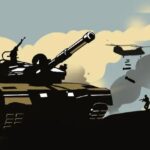
It would be unwise for the government to consider an army withdrawal from the Kashmir valley before taking de-escalation measures
By Vikas Gupta
The Wire, 22 February 23
A report based on the source in the Indian Expressquoted “officers of the security establishment” to report that the Union government is proposing to “completely withdraw the Indian Army from the hinterland of the valley”.
“If approved, the military will only have a presence on the Line of Control (LoC),” says the Indian Expressreport.
The report states that this proposal has been under discussion for approximately two years and is now at an advanced stage with the involvement of the Union Ministry of Defense (MoD), Union Home Ministry (MHA), armed forces and J&K police.
The report has not been corroborated by any government official or spokesperson, but ruling party spokespersons on TV talk shows and debates defend the claims.
However, several questions remain unexplained and deserve to be examined.
Firstly, the army withdrew already several years ago from the hinterland of the valley. With the formation and growth of Rashtriya Rifles from the early 1990s, the expansion of J&K police and the induction of many Central Armed Police Forces (CAPFs), such as the Central Police Force Reserve Force (CRPF), in J&K, these forces were given responsibility for the security of major cities in the state.
The army thereafter had only its main headquarters, such as the headquarters of the 15th Corps at Badami Bagh in Srinagar, located in the hinterland, as well as logistical units such as military depots. supplies, ammunition depots, transit camps, etc.
Since then, the army has been tasked with two major security tasks: the defense of the Line of Control, where it is deployed face to face with the Pakistani army; and management of the counter-infiltration grid (CI grid).
The CI Grid is located between the LoC and the hinterland and exists to kill or capture militants who manage to sneak through the LoC and the formidable border fence reinforced with barbed wire, searchlights, and acoustic and other sensors.
Deployments on the LoC and the CI Grid are considered too difficult and dangerous to be entrusted to the CRPF. It is occupied by the Rashtriya Rifles and the army.
The army has two divisions in Kashmir for these tasks, as well as three divisions in the Jammu region. These total about 125,000 soldiers. These are reinforced by approximately 60,000 Rashtriya Rifles soldiers, who operate under five “force headquarters”.
The government has not provided any figures indicating a reduction in these numbers.
Furthermore, it remains unclear how the military can initiate a withdrawal from the Kashmir Valley before taking de-escalation measures such as the selective removal of the Armed Forces Special Powers Act (AFSPA) or the draconian law on public security, which authorizes the detention of any individual for a maximum of two years.
There have also been no Assembly elections in the state since 2014. Local politicians have questioned how the former state can be considered peaceful enough for the army’s withdrawal as the normal political activity remains suspended and full statehood for J&K remains suspended.
Meanwhile, militant infiltration across the LoC remains at an all-time low, as does militant activity within the former state. Yet local politicians point to a deep alienation among the population, which they say can only be corrected by resuming political activity and granting a full-fledged state that existed before August 2019.






